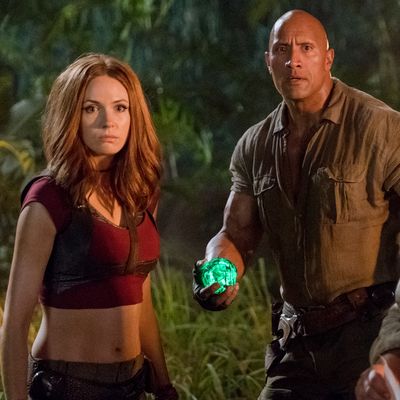
Looking for a lively, wholesome movie to see with the family this holiday season? The obvious choice is The Greatest Showman, the musical that demonstrates how circus impresario P.T. Barnum (Hugh Jackman) didn’t exploit “freaks” by charging people money to point at them and jeer — he actually gave them a sense of self-worth! My colleague Emily Yoshida dissects the “incredibly specious empowerment metaphor holding up this rinky-dink tent” with painful accuracy — and should get combat pay for attempting to transcribe the numbskull lyrics. Move on to the next screen at the multiplex (plug your ears if you’re passing The Greatest Showman) and see Jumanji: Welcome to the Jungle. The movie has amusingly broad performances; good, bloodless scares (the characters die horribly — but have multiple lives); and self-empowering life lessons too bland to be specious. You could do far worse.
Jumanji: Welcome to the Jungle is a sequel to and not a remake of the agreeable 1995 Jumanji (starring Robin Williams and the young Kirsten Dunst) based on Chris Van Allsburg’s wonderful 1981 book. In the 1995 film, players of the mysterious board game Jumanji found their reality invaded by sundry animal, human, and insect predators. In the 21st-century version, four very different kinds of teenagers in detention — yes, it’s a Breakfast Club redux — get whisked into a jungle cyberworld where they find themselves inhabiting wildly inapposite avatars.
The upshot is that Dwayne Johnson (playing a nerd who finds himself in Dwayne Johnson’s body) gazes on his own humongous biceps with the same kind of amazement that the rest of us do, while Karen Gillan (the repository of the brainy misfit girl) looks down at her impossibly long legs as if thinking, “How do I walk on these things?” Jack Black (inhabited by a blonde high-school girl) simpers in horror at his own squat reflection, while the diminutive pop-top Kevin Hart — the avatar of a black kid built like a linebacker — screams, “Where’s the rest of me?”
The plot is by the numbers, but that’s okay since the characters are inside a game in which the plot is by the numbers. They need to work together to survive various lethal obstacles (rhinos, hippos, wildcats, Bobby Cannavale) and restore a precious gem to its rightful place atop a mountain. If they don’t, they’ll be stuck in the game forever. The proof is in the form of Nick Jonas as the avatar of a guy who has been there since 1996, when someone evidently found the Jumanji board game that was tossed away in Jumanji.
If director Jake Kasdan will never be confused for an action stylist, he’ll never be taken for a stumblebum, either. He hits his marks. And who cares if the CGI looks artificial? It’s an artificial world. Actually, I wish that Jumanji: Welcome to the Jungle had looked even more artificial — that Kasdan had pushed the boundaries. Why stick with the jungle when there could have been multiple settings — Camelot, the Old West, outer space? Maybe those will be the sequels. Can the filmmakers come up with new ways to showcase Johnson’s pecs?
It’s fun to watch Johnson use the sight of his own body to teach himself not to run screaming from peril and get up the nerve to kiss Gillan, who has to learn to smolder like a femme fatale, as well as come to terms with her sudden talent for martial arts. (Gillan is a superb physical comedian — it’s as if she’s standing outside herself watching her own body kick ass.) All the characters have to learn that they “only get one life,” even though they actually get three, which comes off as a mixed message. The Greatest Showman lyricists would have tried to make a song out of that:
You only get one life/
Or maybe three/
So go and ride your light/
Into a tree/
’Cause you’ll come back again/
And get eaten by a rhino/
La-la-la albino …


